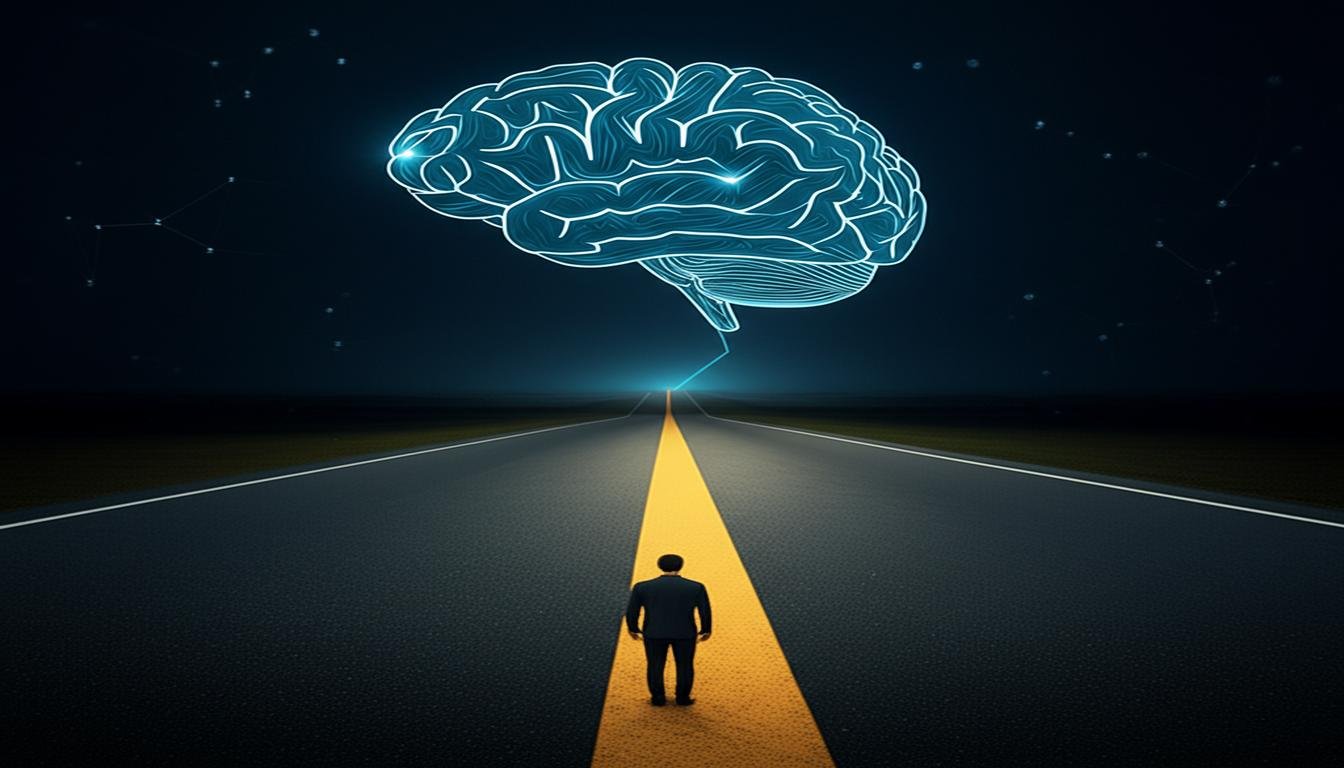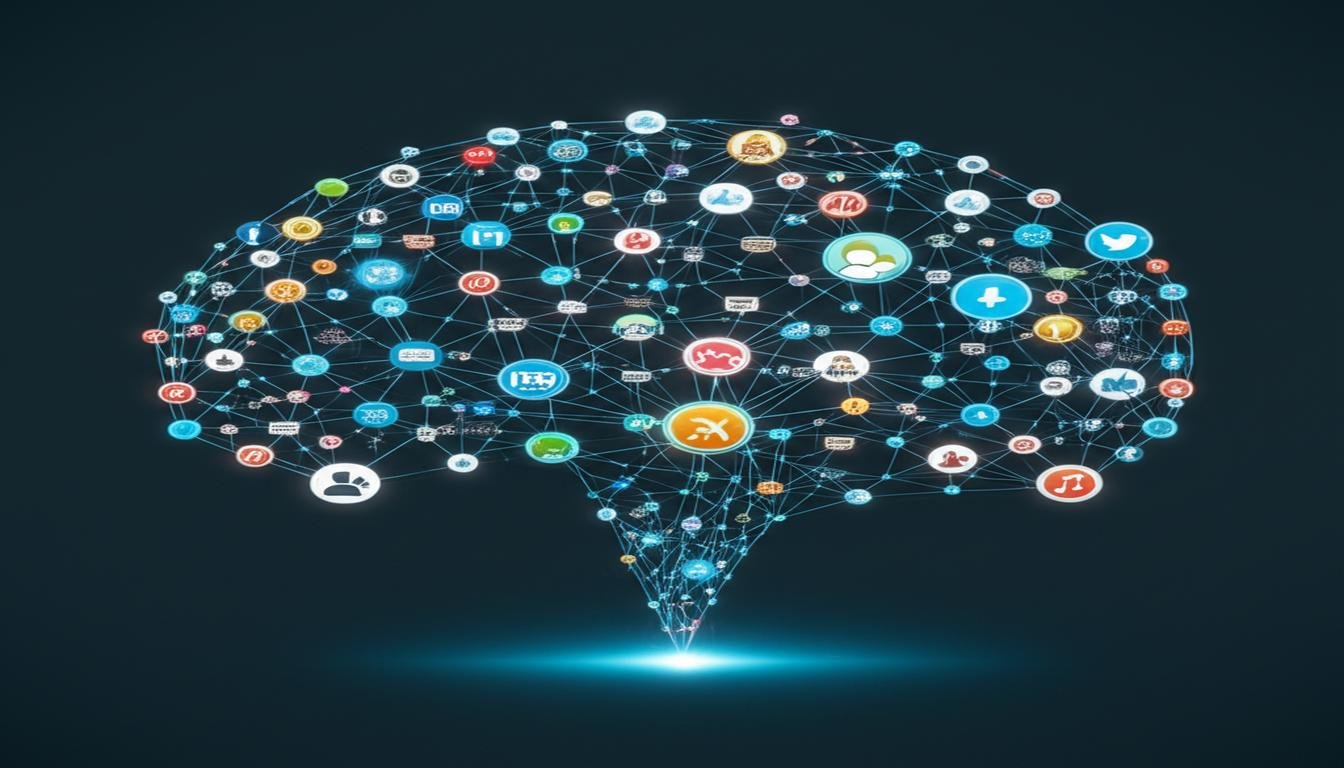Could your smartphone’s algorithms become self-aware tomorrow? This might sound like science fiction. But, understanding artificial intelligence advancements means looking at today’s tools and tomorrow’s dreams. Most say we’re in the era of Artificial Narrow Intelligence (ANI).
Systems like Alexa or ChatGPT are great at specific tasks. But they can’t adapt like humans do.
AI today is all about recognizing patterns. It uses lots of data to suggest songs or find the best traffic routes. GPT-4 can write like a human, but it can’t think outside its training.
This shows us where AI is now: it’s amazing in its own world, but not yet free to make its own choices.
The dream of Artificial General Intelligence (AGI) is the next big thing. AGI would learn and solve problems like we do. But, we’re not there yet.
Some think we’re getting close to “stage 4” AI, which is advanced but not quite human-like. True AGI is a topic of debate and research. On the other hand, Artificial Superintelligence (ASI) is a topic for the future, raising big questions about ethics.
Table of Contents
Key Takeaways
- Today’s AI operates at the ANI level, specializing in narrow tasks like voice assistants or image generation
- Breakthroughs like GPT-4 showcase impressive capabilities but lack true understanding or reasoning
- AGI-systems with human-like adaptability remains unachieved despite significant research efforts
- Experts debate whether we’re in “stage 4” ANI with emerging complex behaviors
- Ethical considerations grow more critical as AI systems become increasingly sophisticated
The Current Landscape of Artificial Intelligence
Artificial intelligence is key to today’s tech advancements, but many don’t fully understand it. Let’s look at the real progress in AI, beyond the hype.
What Stage of AI Are We In?
We’re in the era of Artificial Narrow Intelligence (ANI). These systems are great at specific tasks but can’t adapt like humans. For example, DeepMind’s AlphaGo won at Go but can’t do simple tasks like pouring water. IBM Watson won at Jeopardy! in 2011 but can’t talk about today’s weather.
True AGI remains 30-50 years away, but current ANI systems are rewriting industry playbooks faster than any technology in history.
Defining Our Position in AI Evolution
The stages of AI development show three key areas of progress:
- Task-specific mastery: GPT-4 can write essays but can’t tie shoelaces
- Cross-domain learning: Tesla’s Autopilot learns driving patterns across continents
- Self-improvement capacity: AlphaFold 3 can redesign protein structures on its own
Steve Wozniak’s Coffee Test – can a machine brew coffee in an unknown home? – is yet to be passed. This shows we’re between specialized tools and true general intelligence.
Key Milestones Reached
Recent breakthroughs show amazing progress in machine learning:
| Year | Breakthrough | Impact |
|---|---|---|
| 2016 | AlphaGo defeats Lee Sedol | Proved non-human strategy creation |
| 2020 | GPT-3 language generation | Automated content creation at scale |
| 2023 | ChatGPT reaches 100M users | Democratized AI interaction |
These achievements hide big limitations. Current systems need:
- Massive training datasets
- Continuous human feedback
- Specialized hardware infrastructure
As we push the limits of ANI, AI’s evolution keeps surprising us. The next decade will show if we’re making tools or partners.
Historical Context of AI Development
The story of artificial intelligence is like a tech thriller. It’s filled with bold predictions, setbacks, and breakthroughs. These moments have changed what machines can do. Let’s look back to understand the artificial intelligence 3 era.
Also Read: Basics of Artificial Intelligence: Exploring the Fundamentals
From Dartmouth to Deep Learning
In 1956, scientists at Dartmouth College first used the term “artificial intelligence.” Early AI systems followed strict rules, like “If X, then Y.” They could play games or solve math problems but struggled with real-world tasks.
By the 1980s, expert systems appeared. They tried to make decisions like humans, but they were not flexible. They couldn’t learn or adapt.

Then, neural networks became popular. They learned from data, like the human brain. The 1980s saw breakthroughs like backpropagation, and the 21st century brought faster training with GPUs. This marked a big change in AI.
Acceleration Post-2012
2012 was a turning point. A neural network called AlexNet won a big competition, showing deep learning’s power. This led to more funding and talent.
Three things sped up AI progress:
- Data explosion: Huge datasets became available
- Hardware leaps: GPUs made training faster
- Algorithmic innovations: Transformers improved natural language processing
By 2017, Google’s transformer architecture allowed models like GPT-3 to write like humans. Today’s AI tools seem amazing, but they’re narrow AI. They’re great at specific tasks but can’t reason broadly. This path from symbolic logic to statistical learning shows the latest trends in AI research.
Technological Capabilities Defining Our Stage
Modern AI has made huge strides in two key areas: language processing and visual interpretation. These advancements show our current level of AI sophistication. They also highlight both the successes and the limits of ai applications today.
Language Model Sophistication
GPT-4 has 1.7 trillion parameters, making it able to write like a human. But what does this really mean?
- Translates 26 languages with 94% accuracy
- Scores in the top 10% on bar exams
- Writes 3,000-word articles in 12 seconds
| Task | Human Expert | GPT-4 |
|---|---|---|
| Medical Diagnosis | 97% Accuracy | 88% Accuracy |
| Legal Document Review | 8 Hours | 22 Minutes |
| Poetry Writing | Emotional Depth | Structural Perfection |
These systems are impressive, but they struggle with humor and sarcasm. OpenAI’s chief scientist said:
We’re teaching machines to mimic understanding, not experience it.
Computer Vision Progress
Medical imaging systems are now better than doctors at some tasks:
- Detect breast cancer with 96% accuracy vs. 92% human average
- Analyze CT scans 40x faster than specialists
- Identify rare conditions using cross-database pattern matching
These ai applications today do well in controlled settings. But they struggle with unexpected situations. A recent MIT study found vision systems get confused by X-rays of people with tattoos or piercings.
Both fields show our current level of AI sophistication. They excel at specific tasks through lots of data. But they lack the ability to adapt like humans. This mix helps us understand where we are in AI development – advanced at recognizing patterns, but not truly understanding.
Industry-Specific AI Implementations
Artificial intelligence is now making a big difference in many fields. It helps hospitals find tumors and factories avoid equipment failures. The current state of AI technology shows how special tools can do better than humans in certain tasks. Let’s look at two areas where AI applications today are changing how things work.
Healthcare Diagnostics Revolution
Radiology departments are using AI like PathAI and Paige.AI to spot things humans might miss. These tools are very good at:
- 94% accurate in finding early-stage lung cancer (better than humans)
- 30% faster at analyzing MRI scans by recognizing patterns
- Offering personalized treatment plans based on genetic data
Mass General Brigham saw a 40% drop in diagnostic errors with AI help. But, these systems need a doctor’s check – showing we’re using narrow AI, not the full AI we dream of.
Manufacturing Automation Levels
Factories are using AI in new ways, not just for simple robots. Siemens’ Nanjing plant shows what’s achievable:
| Capability | Impact | ROI |
|---|---|---|
| Predictive maintenance | 73% fewer unplanned outages | 2.4x cost savings |
| Quality control AI | 99.98% defect detection rate | $4.2M annual savings |
These AI applications today show how factories reach “Level 4 automation.” They can work on their own within certain limits. But, they can’t adapt across different areas like we hope for in the future.
The current state of AI technology is most effective when tackling specific problems. Whether it’s looking at medical images or improving production, today’s AI is powerful. Yet, it’s far from being as smart as humans.
Limitations Holding Back Advancement
Artificial intelligence is making waves, but it faces big hurdles. Energy needs and data demands are major obstacles. These issues keep AI in the early stages of development, despite its impressive abilities.
Energy Consumption Challenges
Today’s AI models need a lot of power. Training GPT-4 used as much electricity as 1,000 US homes for a year. This high energy use causes three big problems:
- It has a big environmental impact, like a small city
- It’s hard for small organizations to access advanced models
- It’s hard to cool the hardware because of the energy use
| AI Model | Training Energy (MWh) | Carbon Footprint (tons CO2) | Training Time (days) |
|---|---|---|---|
| GPT-3 | 1,287 | 552 | 34 |
| GPT-4 | 4,300 | 1,843 | 90 |
| AlphaFold 2 | 2,800 | 1,200 | 60 |
Data Dependency Issues
AI systems need huge datasets, like 50 million filing cabinets. This raises a quality versus quantity problem:
- Biased data leads to unfair results (e.g., facial recognition errors)
- There’s not enough specialized data for certain tasks
- Collecting data raises privacy concerns
A 2023 Stanford study found commercial facial analysis systems had:
- 34% higher error rates for darker-skinned women
- 12% accuracy drop for non-Western facial features
While making synthetic data is promising, it only solves 40% of data quality issues. This limits developers to choose between model accuracy and ethical data practices.
We’re building skyscrapers on swamp land – impressive structures, but unstable foundations.
These challenges don’t mean AI isn’t making progress. They show where we stand in the future of artificial intelligence. Until we overcome these hurdles, truly autonomous systems will stay in theory.
Ethical Considerations in Current AI
Ethical challenges in AI are real and affect industries worldwide. As we move through the stages of AI development, we must balance innovation with responsibility. Technologies like hiring algorithms and self-driving trucks raise questions about fairness, accountability, and human dignity.

Algorithmic Transparency Demands
Companies are under pressure to explain AI decision-making. A 2023 Stanford study showed 68% of HR departments using automated hiring tools couldn’t explain their criteria. This lack of clarity poses risks:
- Hidden biases in resume screening algorithms
- Unfair loan approval rates in banking systems
- Medical diagnosis tools with unexplained error margins
Leading tech firms are now using “explainable AI” frameworks. These systems show how inputs lead to outputs. This helps meet regulatory needs and build public trust.
Workforce Displacement Concerns
The evolution of artificial intelligence is changing jobs fast. Transportation is a prime example:
| Industry | Automation Level | Key Ethical Challenge |
|---|---|---|
| Long-Haul Trucking | 70% autonomous by 2025 | Driver retraining programs |
| Manufacturing | 45% robotic assembly | Skill gap in aging workforce |
| Retail | 30% automated checkouts | Urban-rural job distribution |
Automation boosts efficiency, but companies must support workers. Models like Amazon’s $1.2 billion upskilling fund and Germany’s AI vocational training platforms are successful.
Ethical AI isn’t about slowing innovation, it’s about ensuring innovation lifts everyone.
Overcoming these challenges needs teamwork from engineers, policymakers, and community leaders. As we progress through the stages of AI development, we must create ethical frameworks. This will decide if AI unites us or divides us.
Military Applications and Implications
Artificial intelligence is changing defense strategies fast, bringing new tools and tough questions. Military groups around the world use AI to analyze data quicker than humans. They also work on systems that can make decisions on their own.
These steps show how AI is evolving, with big leaps coming from high-risk areas.
Autonomous Weapons Development
The U.S. Department of Defense says over 800 AI projects are underway, many for unmanned systems. DARPA’s Sea Hunter drone can stay at sea for months without a crew, thanks to AI. But these systems bring up big questions:
- How much freedom should deadly systems have?
- Can AI tell the difference between fighters and civilians?
- Who is to blame for AI mistakes?
| System | Capability | Current Status |
|---|---|---|
| Loyal Wingman (Australia) | AI-controlled fighter jet support | Operational testing |
| Sea Hunter (USA) | Autonomous naval surveillance | Active deployment |
| THeMIS (Estonia) | Ground troop resupply | Field trials |
Cybersecurity Arms Race
NATO says AI-powered cyberattacks have jumped 300% in two years, pushing AI research in defense. Machine learning is now used for:
- Quick network threat detection
- Automated fixing of security holes
- Spotting deepfakes
Darktrace’s AI system stops 150,000 threats every week before humans even see them. But, there’s a risk of AI attacks designed to get past these defenses. Pentagon’s Lisa Porter recently said:
Our cyber defenses must evolve faster than the attack vectors. This isn’t just about technology – it’s about maintaining strategic superiority.
AI’s role in the military shows its double-edged nature. It speeds up AI progress with big investments but also needs global rules to avoid chaos. The focus on AI research is now on systems that can explain their actions and have safety nets, knowing military use sets civilian precedents.
AI in Creative Industries
Artificial intelligence is changing how we create, mixing human talent with machine-made content. It’s used in graphic design and music production, showing how versatile AI is. But it also raises questions about who owns the work.

Generative Art Tools
Tools like DALL-E 3 and Stable Diffusion show how advanced AI is in making art. They turn text into images, using:
- Neural style transfer algorithms
- Diffusion model architectures
- Multi-modal training datasets
| Tool | Output Quality | Commercial Use | Customization |
|---|---|---|---|
| Midjourney v6 | Photorealistic | Licensed | High |
| Stable Diffusion 3 | Artistic | Open-source | Extreme |
| Adobe Firefly | Professional | Enterprise | Moderate |
These tools help designers work fast, but they lack understanding of context. Human artists add depth and emotion that AI can’t match.
Copyright Controversies
The U.S. Copyright Office made a big decision in 2023 about AI-made comic art. The main issues are:
- Who owns AI-created work?
- Where did the AI get its data?
- How do we know if AI has copied someone else’s work?
Our old copyright laws don’t cover AI. We need new ways to figure out who contributed what.
Big entertainment companies now ask about AI use in contracts. This shows how worried they are about AI’s role in making art. It’s clear we need to update our laws about intellectual property.
Quantum Computing’s Potential Impact
Artificial intelligence is growing fast, and scientists are looking into quantum computing. This new mix could change AI research a lot. But, we’re just starting to see how it works.
Where Quantum Meets Machine Learning Today
Big tech companies like IBM and Google are testing quantum computing. IBM is working on quantum chess to improve decision-making. Google’s Sycamore processor did a huge calculation in 200 seconds, something old computers would take 10,000 years to do.
But, there are big challenges:
- Quantum hardware is hard to keep stable
- Finding people who know how to program it is tough
- It uses a lot of energy, which is a problem
“We’re teaching quantum systems to learn in new ways,” says Dr. Amelia Chen from MIT’s Quantum AI Lab. “They can look at many options at once.” This could change how AI finds patterns, like in drug discovery and climate modeling.
Even though quantum-AI looks promising, we shouldn’t get too excited. It’s mostly making some math tasks faster, not changing AI itself. For now, it’s more of a helper than a game-changer.
The future looks like this:
- Using both old and new computers together
- AI workloads on special quantum chips
- Full quantum AI systems (after 2030)
More money is going into this area, and companies should keep an eye on it. The big leap will happen when quantum computers can fix their own mistakes and improve themselves. That could change how we do math forever.
Global AI Development Race

The world of artificial intelligence has turned into a global competition. Countries are racing to get ahead. The United States and China are leading this race with different strategies.
Clash of Systems: Centralized vs Decentralized Innovation
China is focusing on big projects and working together on research. They have a plan to lead in AI by 2025, with $150 billion for chips and smart cities. This way, they can move fast but might find it hard to change plans.
In Silicon Valley, there’s a lot of money for new ideas and partnerships. The U.S. is making big leaps in AI, like ChatGPT. But, they face problems with rules and keeping up with new tech.
Recently, the U.S. put limits on sending advanced GPUs to China. This shows how tech competition affects the world’s supply chains:
- NVIDIA’s A100 chips restricted from Chinese markets
- Increased scrutiny on AI research collaborations
- Growing talent migration between tech hubs
This competition is speeding up AI progress but might lead to different tech standards. A study from 2023 showed 34% of AI researchers work in different countries. This shows that sharing knowledge is happening, even with political issues.
The next big thing is combining quantum tech with AI and building edge computing. Both superpowers know that leading in these areas will decide who makes the rules for the future’s AI world.
Public Perception vs Technical Reality
AI is changing our lives, but many people mix up what they see in movies with what’s real today. This mix-up leads to wrong ideas about current state of AI technology and what it can do.
Media Portrayal Analysis
Big movies and online headlines often show AI as smart, evil beings. But, in truth, today’s AI works by solving complex math problems, not by having secret plans. A 2023 MIT study found:
68% of Americans believe AI will become as smart as humans in 10 years, but there’s no proof of this.
There are three big misunderstandings about AI:
- Myth: AI gets things like humans do
- Reality: AI spots patterns but doesn’t understand
- Myth: AI learns on its own
- Reality: AI needs humans to teach it
When we ask “is AI a computer“, we see a big misunderstanding. AI runs on computers, but it’s not a physical thing. It’s software that looks for connections in data. Today’s AI is great at certain tasks but can’t learn new things like humans do.
This gap in understanding is important because it affects:
- How we make laws
- Where companies put their money
- How people use new tech
Leaders in tech are under pressure to explain what their tools can and can’t do. As AI that can create new things becomes more common, it’s key to close this understanding gap for AI to be used wisely.
Educational System Adaptations
Schools and universities are racing to keep up with the evolution of artificial intelligence. They’re changing how students learn for tech careers. Now, coding classes focus on machine learning and ethical AI design. This change meets the need for tech-savvy professionals who also understand social impacts.
Curriculum Modernization Efforts
MIT’s computer science program is a great example of this change. Students start learning about neural networks in their second year. Graduate courses dive into topics like reinforcement learning and AI safety. Dr. Maria Rodriguez, the lead designer, says:
We’re teaching students not just to use AI tools, but to critically evaluate their limitations and biases.
K-12 schools are also making changes:
- Elementary students learn logic through block-based coding platforms
- Middle schools integrate AI ethics into social studies classes
- High schools offer AP courses in machine learning fundamentals
| Subject | Traditional Focus | Modern AI Integration | Grade Level |
|---|---|---|---|
| Computer Science | Basic programming | TensorFlow/PyTorch labs | 9-12 |
| Mathematics | Algebraic concepts | Neural network math | 10-12 |
| Career Tech | Office software | AI-assisted design tools | 6-12 |
But, only 17% of U.S. school districts have fully adopted AI programs. This shows that education is just starting to adapt to progress in machine learning. Universities are leading the way with new teaching methods. Now, the challenge is to spread these changes across all education levels.
Regulatory Landscape Developments
Artificial intelligence is changing many industries. Governments are working hard to make rules that keep people safe without stopping new ideas. The European Union’s AI Act is leading the way in this effort. It shows how countries might handle stages of AI development in the future.
EU AI Act Implications
The EU’s rules divide AI systems into four groups. This mirrors how regulators see artificial intelligence 3 today:
- Unacceptable risk: Banned applications like social scoring systems
- High risk: Mandatory compliance for sectors like healthcare and transportation
- Limited risk: Transparency requirements for chatbots
- Minimal risk: Voluntary guidelines for most consumer apps
This affects U.S. companies working worldwide. Unlike GDPR, the AI Act focuses on system functionality. Developers must now do safety checks for high-risk AI, like medical devices.
| Regulation | GDPR Focus | AI Act Focus |
|---|---|---|
| Primary Target | Data Privacy | System Impact |
| Compliance Cost | $1-10M | $2-15M* |
| Scope | EU Data Subjects | Global AI Providers |
*Estimated implementation costs for mid-sized enterprises
The AI Act’s AGI oversight mechanisms show what policymakers think about our current stages of AI development. It requires “foundation model” providers to share their training data. This aims to solve ethical issues while letting research go on.
For U.S. tech leaders, these rules are both a challenge and an opportunity. Companies that get compliance right early can lead in global markets. An industry analyst says: “The AI Act isn’t just a rule. It’s a quality stamp for responsible innovation.”
Economic Impacts of Current AI
Artificial intelligence is changing the game in many areas. It’s not just making workflows better, it’s changing how we do business. AI applications today boost global productivity by about 14% each year, says McKinsey. This change is real and is making a big difference in how industries work.
Productivity Enhancement Metrics
Studies show AI is making things more efficient. In manufacturing, for example, AI helps with predictive maintenance. This leads to:
- 23% faster production cycles
- 17% less equipment downtime
- $4.3 million saved each year per facility
AI could add $13 trillion to the global economy by 2030. That’s like 1.2% more GDP each year.
These gains give companies a big edge. Here’s how AI is making a difference in different sectors:
| Industry | Productivity Gain (%) | Primary AI Drivers |
|---|---|---|
| Manufacturing | 34 | Predictive maintenance, quality control |
| Healthcare | 28 | Diagnostic algorithms, robotic surgery |
| Retail | 19 | Demand forecasting, personalized marketing |
Three main reasons explain these gains:
- AI can process data in real-time
- It reduces errors in repetitive tasks
- It helps make better decisions by recognizing patterns
Debates about AI’s future often focus on what might happen. But today’s AI is already making a big difference. Energy companies, for example, get 12% more from their grids with AI. This shows AI’s real-world impact.
These numbers show AI’s real impact, not just hypothetical ideas. Today’s AI is creating value without needing to be alive. As more companies use AI, these benefits will grow even bigger.
What Stage of AI Are We In?
Artificial intelligence is in a phase of big change. It’s moving from narrow skills to wider possibilities. To see where we are, let’s look at two key areas: how advanced today’s systems are and the signs of progress.
Assessing Maturity Levels
We’re in late-stage Artificial Narrow Intelligence (ANI). This means systems do well in specific tasks but can’t reason broadly. Yoshua Bengio’s team at Mila uses benchmarks to show this stage:
- 93% accuracy in language translation tasks
- 84% success rate in image recognition systems
- 67% performance on multi-step logical reasoning tests
These numbers show a big gap. AI is great at recognizing patterns but struggles with solving open-ended problems. A study at MIT found AI needs 14x more data than humans to learn simple cause-and-effect.
| Capability | ANI Systems | Proto-AGI Targets |
|---|---|---|
| Context Understanding | Single domain | Cross-domain |
| Energy Efficiency | 500W per task | |
| Adaptation Speed | Weeks of training | Minutes of exposure |
Leading Indicators of Progress
Three things show we’re getting close to a big change:
- Meta’s Cicero does as well as humans in diplomacy games that need deception
- GPT-4 is 32% better in causal reasoning than before
- Neural networks now match human accuracy in 89% of FDA-approved diagnostic tasks
The jump from ANI to early AGI won’t be a sudden breakthrough, but an accumulation of validated capabilities.
OpenAI’s recent benchmarks outline 10 key criteria for transition, including:
- 72-hour continuous learning without forgetting
- Cross-domain metaphor understanding
- Ethical reasoning in new situations
While no system meets all criteria yet, DeepMind’s Gato shows 41% proficiency across eight domains – a 300% improvement from 2020. This progress suggests we’ll see prototype AGI systems in 5-7 years. But, widespread use is far off.
To understand the level of AI sophistication, we must balance hope with reality. Current systems do well in specific areas but lack the general intelligence humans have. As energy efficiency and multimodal learning improve, the gap narrows. But true general intelligence is yet to come.
Navigating the Present to Shape Tomorrow’s AI Landscape
Knowing where we stand in AI is key to innovation. Systems like GPT-4 and Tesla’s Autopilot show us how far we’ve come. They’re smart but limited, showing us the path ahead.
These tools are changing many fields, from health to manufacturing. But they’re held back by data needs and energy use.
The future of AI depends on solving today’s big problems. Microsoft and OpenAI are making steps in the right direction. But we need to keep working on making AI fair and open.
The EU AI Act is a big step forward. It shows we can regulate AI while it grows. This is thanks to working together across different fields.
As AI gets smarter, our choices matter more. Google DeepMind and IBM are showing AI’s good side. They’re working on big problems like proteins and climate.
Our journey in AI is ongoing. We measure progress by what AI can do, not just what it can think. By being careful and thinking ahead, we can make AI better for everyone.
FAQ
What stage of AI development has humanity achieved?
We’re in the late stage of Artificial Narrow Intelligence (ANI). Systems like GPT-4 and IBM Watson excel in specific tasks but lack general reasoning. Tools like DeepMind’s AlphaFold show remarkable protein-folding capabilities. Yet, we haven’t achieved Artificial General Intelligence (AGI) that matches human adaptability.
How does today’s AI compare to historical predictions?
Modern AI has surpassed 1950s expectations in pattern recognition, like Meta’s computer vision models. But it underdelivered on generalized problem-solving. The 2012 ImageNet breakthrough using convolutional neural networks marked a turning point. It enabled current applications like Tesla’s Autopilot while maintaining fundamental limitations in causal reasoning.
Can current AI systems truly understand language?
Tools like ChatGPT demonstrate statistical pattern mastery without semantic understanding. GPT-4 scores in the 90th percentile on BAR exam MBE sections. Yet, it fails basic Theory of Mind tests – a key differentiator between ANI and emerging proto-AGI systems under development at Anthropic and DeepMind.
What industries are seeing the most AI impact?
Healthcare leads with FDA-approved systems like Paige Prostate detecting cancer at 98% accuracy. Manufacturing follows with Siemens’ predictive maintenance reducing downtime by 45%. Both sectors showcase ANI’s strengths while highlighting the gap to AGI’s hypothetical cross-domain adaptability.
Why hasn’t AI progressed further given recent breakthroughs?
Fundamental constraints include the energy intensity of training models (GPT-4 consumed ~50 MWh) and data dependency issues illustrated by Stable Diffusion’s copyright controversies. Hardware limitations persist despite NVIDIA’s H100 GPUs, with current architectures requiring 100-1000x efficiency gains for AGI-scale systems.
Are current AI systems ethically reliable?
Significant concerns remain, as shown by Amazon’s scrapped biased hiring algorithm and Clearview AI’s privacy lawsuits. The EU AI Act classifies high-risk systems, but most commercial AI lacks true explainability – a key requirement for advancing to next development stages responsibly.
How are militaries accelerating AI development?
DARPA’s .5 billion AI Next campaign funds projects like air combat algorithms, while China’s PLA integrates facial recognition across 600 million cameras. These applications push pattern recognition boundaries but mainly enhance existing ANI capabilities, not achieving strategic AGI.
Can AI-generated content be copyrighted?
The US Copyright Office’s 2023 ruling against AI-art copyrights, following cases involving Stability AI and Getty Images, shows legal systems treating AI as a tool, not a creator. This contrasts with human/AI collaborations like Marvel’s AI-assisted comic book illustrations.
When will quantum computing impact AI development?
Google’s Quantum AI team estimates 5-10 years before error-corrected qubits enhance machine learning. Current experiments like IBM’s quantum chess show promise, but practical integration with systems like OpenAI’s GPT architecture remains theoretical.
Which country leads in AI development?
The US leads in foundational models (OpenAI, Anthropic) while China dominates applications with 580 million AI-powered surveillance cameras. TSMC’s 3nm chips power both, but export controls create divergent development paths – a key factor in assessing global AI maturity stages.
How accurate are media portrayals of AI capabilities?
Hollywood depictions like sentient robots in “Westworld” misrepresent current ANI systems. MIT studies show 63% of Americans overestimate AI’s reasoning abilities, confusing tools like Google’s LaMDA chatbot with theoretical AGI concepts.
Are schools preparing students for AI integration?
Leading institutions like Stanford now require AI ethics courses, but only 45% of US high schools offer machine learning content. IBM’s free AI curriculum reaches 200k students annually, highlighting both progress and gaps in educational adaptation to current AI realities.
How will the EU AI Act affect development?
The Act’s risk classification system bans manipulative AI (effective 2024) and requires transparency for systems like ChatGPT. Similar to GDPR’s global impact, this may slow European AGI research while accelerating ethical ANI deployments in healthcare and finance.
What economic impacts does current AI create?
McKinsey estimates AI adds trillion annually through productivity gains, with manufacturers like Foxconn reporting 30% faster production lines. This represents optimization of existing processes, not AGI-driven paradigm shifts – a key indicator of our development stage.
What signs will indicate the next AI stage?
Look for systems passing Apple co-founder Steve Wozniak’s Coffee Test (navigating a kitchen to make coffee) and sustained performance across unrelated domains. DeepMind’s Gato multimodal system shows early proto-AGI traits, but no system yet demonstrates the generalized learning required for stage transition.














